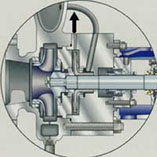 "Multiplicity ought not to be posited without necessity." — Occam's Razor Otherwise stated: |
Pump Innovation Reduces Motor SizeThe new innovation effectively creates two pumps-in-oneSelected by Les Kane, Stephany Romanow-Garcia and David Nakamura, Editors Where HPI process conditions incorporate high-head, low-flow slipstreams, such as with fractionator reflux services, common practice is to oversize pumps to envelop the slipstream requirements. It is often not practical to use a second small pump. A recent innovation [Split Flow] incorporates an auxiliary low-flow impeller in an API Standard 610 overhung process pump. It allows the pump to separate the inlet flow into a primary high-flow, low-head discharge and a secondary lower-flow, higher-head discharge. The pump is effectively two pumps-in-one, with each impeller selected for the discrete process requirements of each flow stream. This Split Flow concept saves energy by allowing use of smaller motors when pumps are sized for two (or more) process conditions with one discharge flow stream at a higher head and lower flow than the other. Two prototype 4-in. x 6-in. x 10-in., 3,600-rpm pumps with 60-hp motors and incorporating the Split Flow feature have been operating in a California refinery since June 1996. (See dislays.) The conventional pump selection would have required 125-hp motors. The only modification to existing standard pumps is to the back cover and shaft. (See displays.) This lends itself to retrofits and de-bottlenecking modifications. Seal selection is not restricted and seal life is not compromized as shaft deflection at the seals is within API standards, i.e., deflection resulting from the slightly longer shaft cantilever is offset by lower dynamic deflection forces due to use of a smaller-diameter, lower-head primary impeller.
Reprinted from Hydrocarbon Processing ® January 1998 issue. |
Reprinted from HYDROCARBON PROCESSING® January 1998 issue.
|
